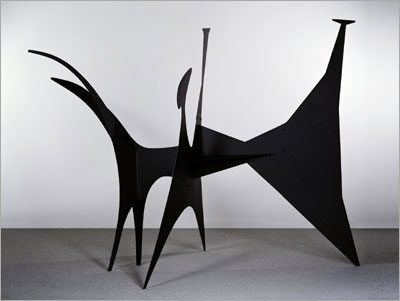

Alexander Calder, Black Beast, 1940
In his iconoclastic poetic novel Les Chants de Maldoror (1869), the Comte de Lautréamont described beauty as "the fortuitous meeting on a dissecting table of a sewing machine and an umbrella."
This bizarre conception encapsulates the Surrealist concept of "convulsive beauty," a term first coined in 1928 by Breton and inspired by the work of artists such as Picasso. While convulsive beauty was sometimes associated with themes of sexuality and the Surrealist Object, it was also used to describe those monstrous and humorous qualities of which Calder made particular use.
Calder's works in this vein have been called "ungainly creature[s] worthy of the most macabre surrealist invention." As he did for many of his Surrealist Objects, like Ashtray Mobile (circa 1951), Calder assembled these sculptures from found materials, and they often underscore an anthropomorphic strain in his work: for example, he fashioned Apple Monster (1938) from the branch of an apple tree, while in Devil Fish (1937) he employed bolted sheet metal to allude to forms in the natural world. Also on display are Calder's "marvelous" (in the Surrealist sense of that word) personages-fantastic, never before seen creatures, such as Untitled (1938) in this gallery and Black Beast (1940) in the next gallery.
